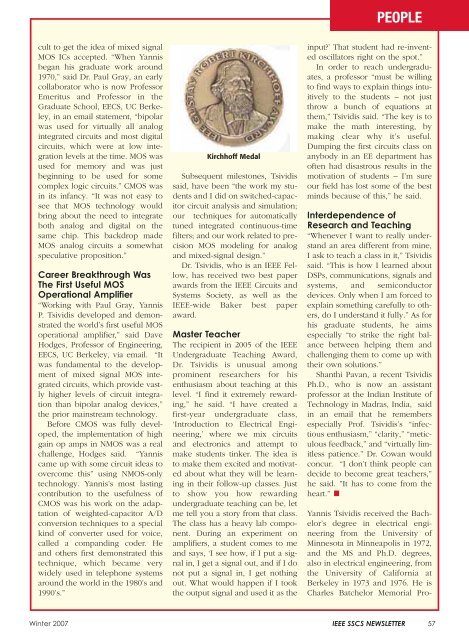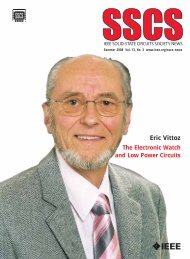The Impact of Dennard's Scaling Theory - IEEE
The Impact of Dennard's Scaling Theory - IEEE
The Impact of Dennard's Scaling Theory - IEEE
- TAGS
- scaling
- www.ieee.org
You also want an ePaper? Increase the reach of your titles
YUMPU automatically turns print PDFs into web optimized ePapers that Google loves.
cult to get the idea <strong>of</strong> mixed signal<br />
MOS ICs accepted. “When Yannis<br />
began his graduate work around<br />
1970,” said Dr. Paul Gray, an early<br />
collaborator who is now Pr<strong>of</strong>essor<br />
Emeritus and Pr<strong>of</strong>essor in the<br />
Graduate School, EECS, UC Berkeley,<br />
in an email statement, “bipolar<br />
was used for virtually all analog<br />
integrated circuits and most digital<br />
circuits, which were at low integration<br />
levels at the time. MOS was<br />
used for memory and was just<br />
beginning to be used for some<br />
complex logic circuits.” CMOS was<br />
in its infancy. “It was not easy to<br />
see that MOS technology would<br />
bring about the need to integrate<br />
both analog and digital on the<br />
same chip. This backdrop made<br />
MOS analog circuits a somewhat<br />
speculative proposition.”<br />
Career Breakthrough Was<br />
<strong>The</strong> First Useful MOS<br />
Operational Amplifier<br />
“Working with Paul Gray, Yannis<br />
P. Tsividis developed and demonstrated<br />
the world’s first useful MOS<br />
operational amplifier,” said Dave<br />
Hodges, Pr<strong>of</strong>essor <strong>of</strong> Engineering,<br />
EECS, UC Berkeley, via email. “It<br />
was fundamental to the development<br />
<strong>of</strong> mixed signal MOS integrated<br />
circuits, which provide vastly<br />
higher levels <strong>of</strong> circuit integration<br />
than bipolar analog devices,”<br />
the prior mainstream technology.<br />
Before CMOS was fully developed,<br />
the implementation <strong>of</strong> high<br />
gain op amps in NMOS was a real<br />
challenge, Hodges said. “Yannis<br />
came up with some circuit ideas to<br />
overcome this” using NMOS-only<br />
technology. Yannis’s most lasting<br />
contribution to the usefulness <strong>of</strong><br />
CMOS was his work on the adaptation<br />
<strong>of</strong> weighted-capacitor A/D<br />
conversion techniques to a special<br />
kind <strong>of</strong> converter used for voice,<br />
called a companding coder. He<br />
and others first demonstrated this<br />
technique, which became very<br />
widely used in telephone systems<br />
around the world in the 1980’s and<br />
1990’s.”<br />
Kirchh<strong>of</strong>f Medal<br />
Subsequent milestones, Tsividis<br />
said, have been “the work my students<br />
and I did on switched-capacitor<br />
circuit analysis and simulation;<br />
our techniques for automatically<br />
tuned integrated continuous-time<br />
filters; and our work related to precision<br />
MOS modeling for analog<br />
and mixed-signal design.”<br />
Dr. Tsividis, who is an <strong>IEEE</strong> Fellow,<br />
has received two best paper<br />
awards from the <strong>IEEE</strong> Circuits and<br />
Systems Society, as well as the<br />
<strong>IEEE</strong>-wide Baker best paper<br />
award.<br />
Master Teacher<br />
<strong>The</strong> recipient in 2005 <strong>of</strong> the <strong>IEEE</strong><br />
Undergraduate Teaching Award,<br />
Dr. Tsividis is unusual among<br />
prominent researchers for his<br />
enthusiasm about teaching at this<br />
level. “I find it extremely rewarding,”<br />
he said. “I have created a<br />
first-year undergraduate class,<br />
‘Introduction to Electrical Engineering,’<br />
where we mix circuits<br />
and electronics and attempt to<br />
make students tinker. <strong>The</strong> idea is<br />
to make them excited and motivated<br />
about what they will be learning<br />
in their follow-up classes. Just<br />
to show you how rewarding<br />
undergraduate teaching can be, let<br />
me tell you a story from that class.<br />
<strong>The</strong> class has a heavy lab component.<br />
During an experiment on<br />
amplifiers, a student comes to me<br />
and says, ‘I see how, if I put a signal<br />
in, I get a signal out, and if I do<br />
not put a signal in, I get nothing<br />
out. What would happen if I took<br />
the output signal and used it as the<br />
PEOPLE<br />
input?’ That student had re-invented<br />
oscillators right on the spot.”<br />
In order to reach undergraduates,<br />
a pr<strong>of</strong>essor “must be willing<br />
to find ways to explain things intuitively<br />
to the students – not just<br />
throw a bunch <strong>of</strong> equations at<br />
them,” Tsividis said. “<strong>The</strong> key is to<br />
make the math interesting, by<br />
making clear why it’s useful.<br />
Dumping the first circuits class on<br />
anybody in an EE department has<br />
<strong>of</strong>ten had disastrous results in the<br />
motivation <strong>of</strong> students – I’m sure<br />
our field has lost some <strong>of</strong> the best<br />
minds because <strong>of</strong> this,” he said.<br />
Interdependence <strong>of</strong><br />
Research and Teaching<br />
“Whenever I want to really understand<br />
an area different from mine,<br />
I ask to teach a class in it,” Tsividis<br />
said. “This is how I learned about<br />
DSPs, communications, signals and<br />
systems, and semiconductor<br />
devices. Only when I am forced to<br />
explain something carefully to others,<br />
do I understand it fully.” As for<br />
his graduate students, he aims<br />
especially “to strike the right balance<br />
between helping them and<br />
challenging them to come up with<br />
their own solutions.”<br />
Shanthi Pavan, a recent Tsividis<br />
Ph.D., who is now an assistant<br />
pr<strong>of</strong>essor at the Indian Institute <strong>of</strong><br />
Technology in Madras, India, said<br />
in an email that he remembers<br />
especially Pr<strong>of</strong>. Tsividis’s “infectious<br />
enthusiasm,” “clarity,” “meticulous<br />
feedback,” and “virtually limitless<br />
patience.” Dr. Cowan would<br />
concur. “I don’t think people can<br />
decide to become great teachers,”<br />
he said. ”It has to come from the<br />
heart.”<br />
Yannis Tsividis received the Bachelor’s<br />
degree in electrical engineering<br />
from the University <strong>of</strong><br />
Minnesota in Minneapolis in 1972,<br />
and the MS and Ph.D. degrees,<br />
also in electrical engineering, from<br />
the University <strong>of</strong> California at<br />
Berkeley in 1973 and 1976. He is<br />
Charles Batchelor Memorial Pro-<br />
Winter 2007 <strong>IEEE</strong> SSCS NEWSLETTER 57




